The Economics and Statistics Division maintains archives of previous publications for accountability purposes, but makes no updates to keep these documents current with the latest data revisions from Statistics Canada. As a result, information in older documents may not be accurate. Please exercise caution when referring to older documents. For the latest information and historical data, please contact the individual listed to the right.
<--- Return to Archive
For additional information relating to this article, please contact:
February 12, 2020HOURS WORKED AND LABOUR PRODUCTIVITY, 1997-2018 [REVISED] Statistics Canada has revised labour productivity accounts for the provinces for 1997-2018. The data is consistent with the provincial gross domestic product(GDP) by industry released in November 2019 with GDP being measured at basic prices. The revisions take into account historical revisions to the Survey of Employment, Payroll hours, improvements to imputation methodology for average hours and wage rates, and activity in cannabis industries. The following DailyStats article has been updated to reflect the latest data.
In 2018, Nova Scotia's labour productivity in the business sector decreased by 2.7 per cent following increases in the previous five years. Canada's labour productivity in the business sector was unchanged in 2018, following an increase of 2.4 per cent in 2017 and 0.4 per cent in 2016. In Nova Scotia, 39.3 dollars (chained 2012) of GDP are produced per hour of work. Nationally, labour productivity in the business sector is 56.3 dollars per hour.
Labour productivity declined 3.6 per cent in Nova Scotia's service-producing sector and declined by 0.4 per cent in the goods-producing sector. In Canada, productivity rose in the goods-producing sector by 0.5 per cent and the services-producing sector had a decline of 0.2 per cent.
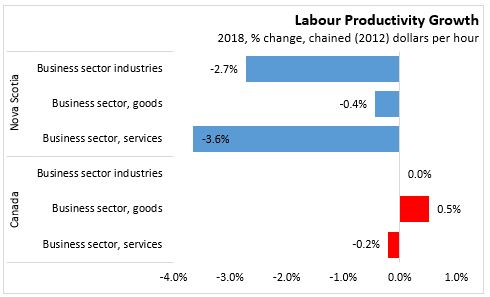
In Nova Scotia, the 2.7 per cent decline in labour productivity was the result of a 1.2 per cent growth in real value added while hours worked increased by 4.1 per cent. Over the past five years, Nova Scotia's business sector labour productivity has increased by 6.2 per cent and total hours worked have increased 1.5 per cent resulting in a 7.8 per cent increase in real value added.
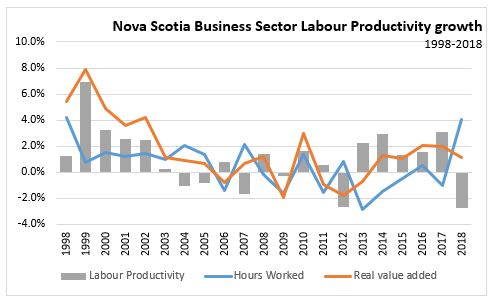
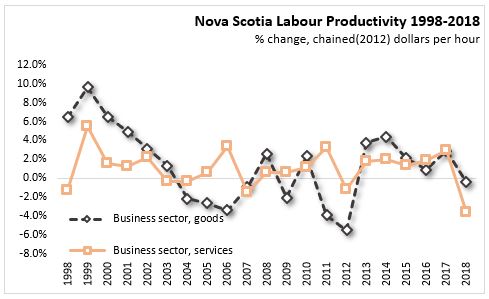
Business sector productivity increased in five provinces in 2018. Saskatchewan (+1.0%), British Columbia (+1.0%), Quebec (0.8%), Manitoba (+0.2%), and New Brunswick (+0.2%).
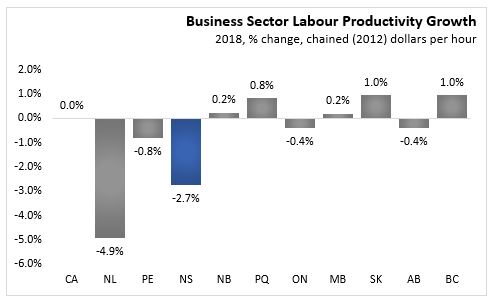
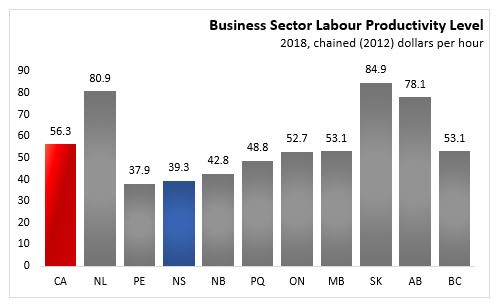
Hours worked in the business sector rose in eight provinces in 2018 with the largest increase in Nova Scotia (+4.1%). Hours worked were lower in New Brunswick (-0.4%) and Newfoundland and Labrador (-0.4%).
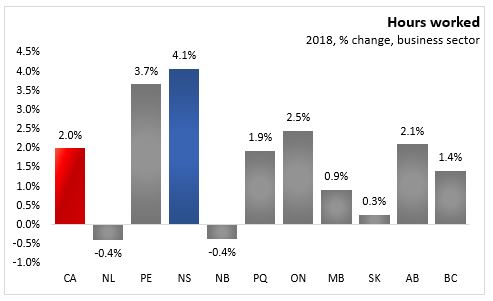
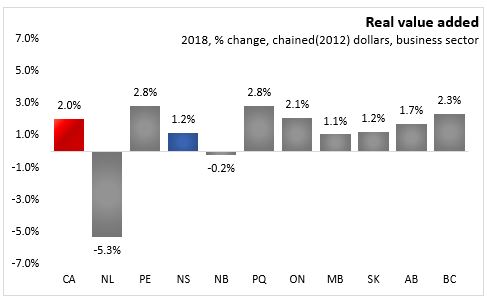
Compensation per hour of work in the business sector was up 0.8 per cent in Nova Scotia to $27.46. Compensation per hour worked was up in nine provinces, with British Columbia (+4.9%) and New Brunswick (+5.0%) reporting the largest gains. Compensation per hour of work increased 2.8 per cent in Canada in 2018.
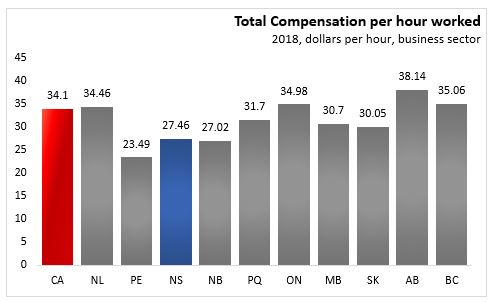
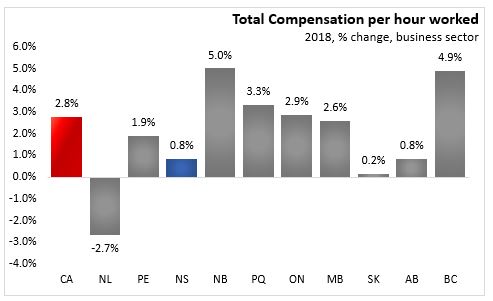
With compensation per hour worked (0.8 per cent) increasing and a declining labour productivity (-2.7 per cent), the unit labour cost (dollars per unit of real GDP) was up in Nova Scotia by 3.9 per cent in 2018. Unit labour costs were up in nine provinces, with New Brunswick (+4.8%), Nova Scotia (+3.9%) and British Columbia (+3.9%) reporting the largest increase. The Canadian average increased 2.7 per cent, with Saskatchewan reporting the only decline. Unit labour costs in US dollars were up in nine provinces, with a decline in Saskatchewan.
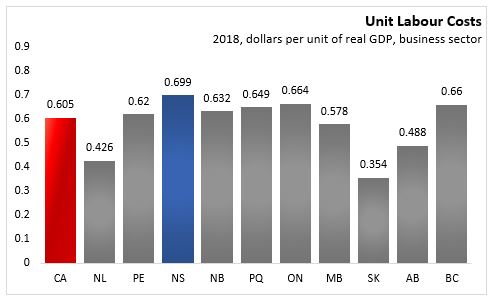

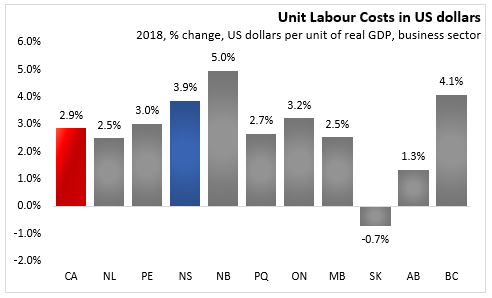
Within Nova Scotia, labour productivity of goods sector was down 0.4 with decreases in utilities (-17.9%), construction (-3.4%), and manufacturing (-0.4%). Labour productivity was up in agriculture, forestry, fishing and hunting (+1.5%) and mining, quarrying, oil and gas extraction (+16.1%).
Business sector service productivity was down 3.6 per cent in 2018. Declines among business sector services included wholesale (-3.8%); retail (-1.1%); transportation and warehousing (-1.0%); finance and insurance and holding companies (-1.4%), professional, scientific and technical services (-6.4%); administrative and support services (-9.2%); arts, entertainment and recreation (-6.9%); accommodation and food services (-12.8%); and other private services (-1.4%). Labour productivity was up in information and cultural industries (+0.6%);educational services - business sector (+1.8%); and health care and social assistance - business sector (+3.3%).
Statistics Canada has indicated that there maybe an error with the Nova Scotia labour productivity data for Real estate, rental and leasing [BS53] and subgrouping of BS53. We advise caution in the use and interpretation of this data at this time. Revisions to the provincial labour productivity tables will be released in May 2020.
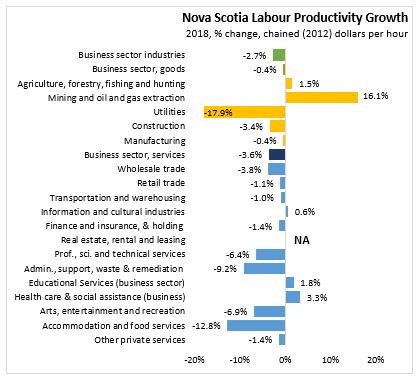
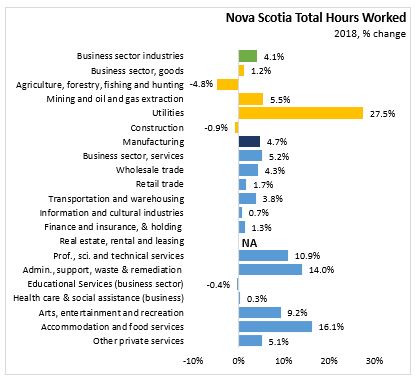
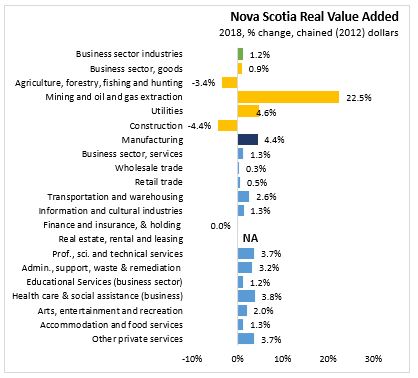
For 2018, Nova Scotia's labour productivity was revised up 0.3 percentage points from -3.0 per cent to -2.7 per cent.
Revisions to Nova Scotia productivity were most notable in 2014 and 2017 with productivity growth estimated at 3.0 per cent (previously 1.9 per cent) in 2014 and 3.1 per cent (previously 1.5 per cent) in 2017. For the past five years, Nova Scotia's labour productivity growth has been revised upwards to a 6.2 per cent increase since 2013 (previously 3.8 per cent).

Note: Data for educational services and health care and social assistance sectors only includes activity related to the business sector. All figures in this report do not include activity of the non-business sector and government sector.
Source: Statistics Canada. Table 36-10-0480-01 Labour productivity and related measures by business sector industry and by non-commercial activity consistent with the industry accounts
<--- Return to Archive